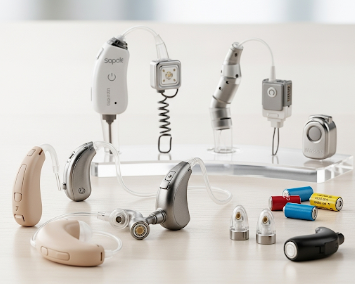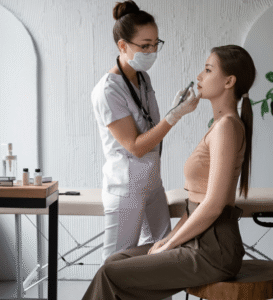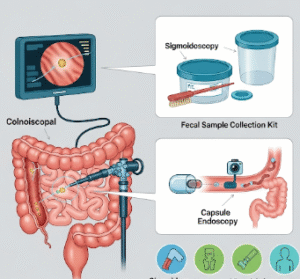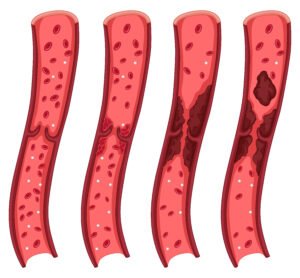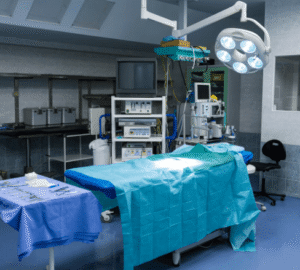What are Hearing Aids and Implants?
Hearing aids and implants are medical devices designed to improve hearing for individuals with partial or profound hearing loss. They work by amplifying sound or directly stimulating the auditory nerve to help individuals perceive sound more clearly.
💡 Key Points About Hearing Devices:
✔️ Hearing aids – Small electronic devices worn in or behind the ear to amplify sound
✔️ Cochlear implants – Surgically implanted devices that directly stimulate the auditory nerve for severe or profound hearing loss
✔️ Bone-anchored hearing devices (BAHD) – Transfer sound via bone conduction, bypassing damaged parts of the ear
✔️ Assistive listening devices (ALD) – Complement hearing aids for specific situations like classrooms or theaters
Types of Hearing Devices:
➡️ Behind-the-ear (BTE) aids – Suitable for mild to profound hearing loss
➡️ In-the-ear (ITE) aids – Custom-fit for mild to severe loss
➡️ Cochlear implants – For individuals with severe sensorineural hearing loss not helped by traditional hearing aids
➡️ Bone conduction implants – Ideal for conductive hearing loss or single-sided deafness
In Korea, these devices are available at audiology centers, ENT hospitals, and specialized cochlear implant clinics, often combined with rehabilitation programs to maximize hearing outcomes.
Why They Are Used
Hearing aids and implants are used to improve communication, enhance quality of life, and prevent social isolation:
✔️ Hearing loss due to aging (presbycusis) – Gradual decline in hearing, common in older adults
✔️ Congenital or genetic hearing loss – Present from birth, often corrected early with cochlear implants
✔️ Noise-induced hearing loss – From occupational or recreational exposure
✔️ Chronic ear infections or otosclerosis – Conductive hearing loss requiring implants
✔️ Trauma or illness – Injury or disease affecting auditory structures
Clinical Benefits:
➡️ Enhanced speech perception → Improved communication in daily life
➡️ Better social interaction → Reduces isolation and depression
➡️ Improved cognitive function → Maintains brain stimulation and auditory processing
➡️ Educational and occupational support → Critical for children and working adults
In Korea, early diagnosis and intervention are prioritized, particularly in children, to ensure optimal language development and learning outcomes.
Alternatives
Depending on hearing loss severity, alternatives may include:
⭐ Lip reading and sign language – Non-technical communication methods
⭐ Assistive listening devices – FM systems, amplified telephones, and TV streamers
⭐ Medical treatment – Treat infections, earwax, or middle ear conditions
⭐ Bone conduction headbands or headphones – Temporary or non-surgical solutions
👉 Key Point: Hearing aids and implants are the most effective solution for moderate to profound hearing loss, while alternatives may supplement communication or treat reversible causes.
Preparation
Preparation ensures successful fitting, surgery, or implantation:
🔹 Audiological assessment – Comprehensive hearing tests to determine type and severity of hearing loss
🔹 Imaging studies – CT or MRI for cochlear implant candidates to assess inner ear structures
🔹 Medical evaluation – Check overall health and suitability for anesthesia if implantation is required
🔹 Counseling – Explain device options, expected outcomes, and rehabilitation process
🔹 Informed consent – Understand risks, benefits, limitations, and device maintenance
⭐ Lifestyle adjustments – Consider daily activities, occupational needs, and device maintenance
⭐ Family involvement – Especially important for children receiving implants
How They Are Done
The procedure depends on the type of hearing device:
- Hearing Aids
✔️ Non-invasive fitting by audiologist
✔️ Custom molds created for in-ear devices
✔️ Device programmed and calibrated for optimal amplification
✔️ Follow-up adjustments for comfort and effectiveness - Cochlear Implants
🔹 Surgery performed under general anesthesia
🔹 Small incision behind the ear, implant inserted into cochlea
🔹 Internal electrode array positioned near auditory nerve
🔹 External processor fitted after healing
🔹 Device programmed for hearing stimulation - Bone-Anchored Hearing Devices
➡️ Surgical placement of titanium implant in the skull
➡️ Sound processor attached after osseointegration
➡️ Bypasses middle and outer ear, stimulating cochlea directly
Highlights:
✔️ Hearing aids require no surgery, while implants are surgical procedures
✔️ Modern cochlear implants in Korea use minimally invasive techniques
✔️ All devices require follow-up programming and rehabilitation
Recovery / Follow-up
Recovery varies depending on device type:
✔️ Hearing aids – Immediate use; initial period of adjustment and calibration over several weeks
✔️ Cochlear implants – Healing 2–4 weeks before external processor activation
✔️ Bone-anchored implants – Osseointegration takes 4–6 weeks before device use
Rehabilitation:
➡️ Auditory training for listening and speech perception
➡️ Speech therapy for children or adults with long-standing hearing loss
➡️ Regular audiology check-ups for device maintenance and software updates
➡️ Support groups or counseling for social adaptation
⭐ Expected outcome: Significant improvement in hearing, speech perception, and communication abilities within months of activation
Complications / Risks
Hearing aids and implants are generally safe, but some risks exist:
⚠️ Hearing aids – Discomfort, feedback noise, or skin irritation
⚠️ Cochlear implants – Infection, device failure, dizziness, tinnitus, facial nerve injury (rare)
⚠️ Bone-anchored implants – Skin irritation, minor infection, implant failure
⚠️ Adjustment period – Some users may experience difficulty adapting to new hearing sensations
➡️ In Korea, high surgical standards, modern device technology, and expert audiology care minimize risks and maximize outcomes.
Treatment Options / Services in Korea
Korea provides comprehensive hearing solutions:
🏥 Audiology centers – Full hearing assessment, hearing aid fitting, and maintenance
🏥 Cochlear implant clinics – Surgical implantation, programming, and rehabilitation
🏥 Bone-anchored hearing device centers – Implantation and follow-up care
🏥 Rehabilitation programs – Auditory training, speech therapy, and social adaptation support
🏥 Advanced technology – Digital hearing aids, AI-assisted cochlear implants, wireless connectivity
Why Korea is a Preferred Destination:
✔️ State-of-the-art audiology and surgical facilities
✔️ Experienced ENT surgeons and audiologists
✔️ Comprehensive rehabilitation programs – Critical for successful outcomes
✔️ High-quality devices and maintenance – Access to latest hearing technology
✔️ Child-focused care – Early intervention and language development programs
Approximate Costs in Korea:
🔹 Hearing aids → $800 – $4,000 per device depending on features
🔹 Cochlear implant surgery → $15,000 – $25,000 including device and surgery
🔹 Bone-anchored hearing device → $5,000 – $10,000 including surgery and processor
🔹 Rehabilitation sessions → $50 – $150 per session
Conclusion
Hearing aids and implants are essential for improving hearing, communication, and quality of life, particularly for individuals with moderate to profound hearing loss.
They help patients:
✔️ Hear more clearly and participate in conversations
✔️ Maintain social interaction and reduce isolation
✔️ Support language development and learning in children
✔️ Improve occupational and daily life functionality
In Korea, patients benefit from:
✔️ Expert audiologists and ENT surgeons
✔️ Advanced devices and surgical techniques
✔️ Integrated rehabilitation programs
✔️ High safety standards and patient-centered care
👉 Key Message: Hearing aids and implants in Korea provide state-of-the-art hearing restoration, ensuring patients achieve optimal auditory function and improved quality of life.

